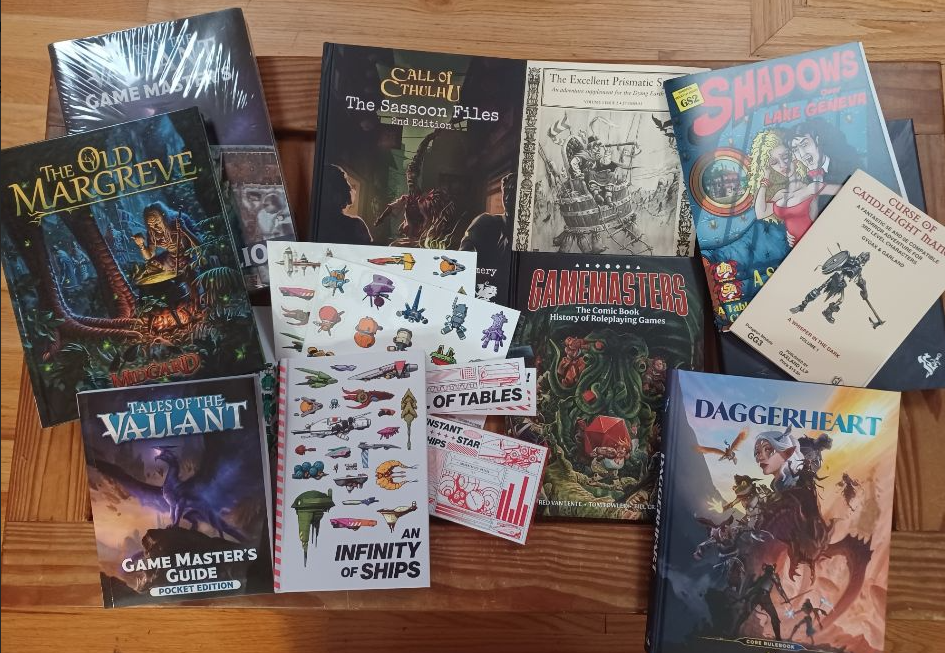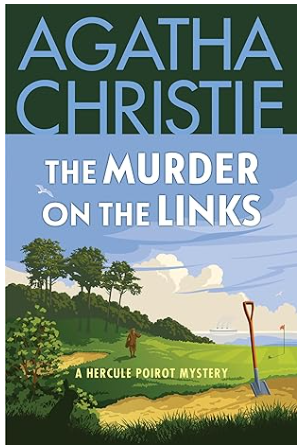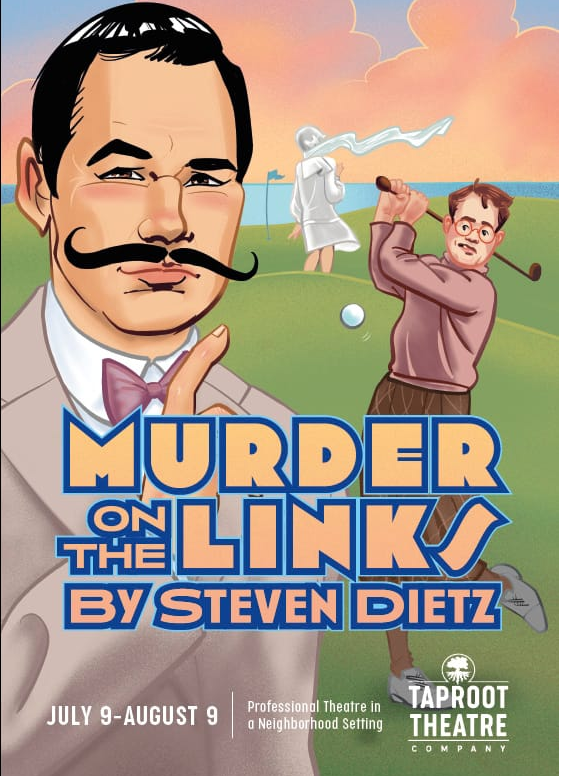So it has been a while, but new games continue to accumulate here at Grubb Street. Some are Kickstarters, but others are from various stores in the area. And I have to say, it's a good thing. There are more game stores operating in the Puget Sound region now than there were 10 years ago, and I am pleased to see brick-and-mortars even as I take advantage of funding new products in advance.
Some of these new projects that have shown up push back the standard limits of what is a role-playing game, and reflect the wide diversity found in the hobby. Some cleave closely to one version of D&D or the other, or have that heady whiff of nostalgia to them, while others challenge a lot of basic assumptions and tropes in the play-style. So this is a mix of old and new
Let' see what's here:
Elder Mythos Deluxe Edition by Michele Paroli and Marta Palvarini, Mana Project Studios, Boxed RPG containing a 240-page digest-sized hardbound, 2 Card Decks, 9 dice, GM Screen, and 10 scenario maps, 2025, Kickstarter. This is a Lovecraftian game where you play. not a cultist or an investigator, but a Mythos Entity itself, both competing with and collaborating with other (player) Mythos entities. It is listed as using the Year Zero engine, but that is pretty much just using that system's dice pools and a card-based initiative session. As an Elder God, you use your turn to manipulate lesser entities (including mere mortals) in the play field, and to mess up the manipulations of the other players, then describing those manipulations in detail. There is a GM/Eldritch Master who is supposed to corral the whole thing. The game play feels like a brain-storming session where there are no bad ideas, but there are bad ideas. The entities you represent stand outside of time, space, and traditional role-playing tropes. The book itself has variable fonts, white on black printing, and a lack of index to help you navigate. So this one would be a learning experience.
Pendragon Gamemaster's Handbook by Greg Stafford et. al, Chaosium, 238-page hardbound, 2024, Wizard's Keep Games. I mentioned there's been a rising tide of game stores in the area, and I was happy to see one of the locals, Wizard's Keep Games, carrying a deeper level of Chaosium products. This Gamemaster's book is a toolkit-style of book on diverse subjects, supporting the core book -- court life, religions, and the supernatural, as well as new rules for running large battles, plus a goodly collection of NPCs and creatures. The presentation on parchment-ish paper is as solid and the art styles are appropriate for the period, and should become a browsable book in my collection..
Call of Cthulhu The Sutra of Pale Leaves: Twin Suns Rising, by Damon Lang, Andrew Logan Montgomery, Jason Sheets, Yukihiro Trada, et al, Chaosium, 192-page hardbound, 2025, Wizard's Keep Games. The past is another country. Japan is another country. An adventure set in Japan in the go-go eighties (40 years ago) is several countries removed. This particular adventure establishes a new manifestation of the King In Yellow and its infiltration into Japanese society. The book deals with Japanese mythology, manga, and the Yakuza, and sets up for a SECOND volume of adventures, Carcosa Manifest. The primary designers come out of the Sons of Singularity, who did The Sassoon Files, and The Blessed and the Blasphemous, and the design here shows a lot of their approach in the form of flowcharts to guide the adventure and confidants to use as plot hooks to bring the players in.
Orbital Blues by Sam Sleney (writing) Josh Clark (art) and Zachary Cox (more writing), Soul Muppet Publishing, 206-page digest-sized hardbound, 2021, Mox Boarding House. An impulse buy, as I note that Mox has slowly be growing its RPG selection over the years, and bringing in some more esoteric titles. Orbital Blues has been out a few years. It is a pretty straightforward game system - a character has three stats (Muscle, Grit, and Savvy) and uses d6s to resolve tasks and combat. Its genre is "Space Western", which includes Firefly, Mos Eisley, and in particular Cowboy Bebop. It's a dystopian setting, where the future has passed through the planets and satellite settlements and then moved on, leaving poverty and oppression in its wake. You're outlaws on the fringe of society, trying to make a dishonest credit by smuggling, bounty hunting, and heists. Also picked up a copy of A Starborne Resistance, a slender 48-page squarebound, which provides a planetary setting of a dying colony ignored and oppressed by a once-mighty Confederacy. The books have that art-book look, in that no two-page spread looks like any others. Lack of an index means you're going to have to remember where you read that particular useful rule. Looks interesting.
Orders of Inquisition by the RPG Professor, Self-published, 120-page softbound, 2025, Kickstarter. This is the sort of product I enjoy, and one that kickstarter excels at bringing to a wider audience. It takes the traditional tropes of gaming fantasy and turns them on their heads. As opposed to the gods (of all alignments) being player-supporting forces, the gods are distant and cruel, and their agents in the world fanatics. The book rolls through the alignment godheads presenting the negative side of faith, followed by specific orders, new classes, spells, and relics. In general, its crammed with some really nice, non-standard ideas. It would be an excellent addition to the more grimdarkish campaigns.
(And as an aside, I always wanted to develop a Good-aligned cult that believes fanatically that the dead should stay dead. Which is a really good thing when talking about vampires, and a really bad thing when you're talking about your fighter who has just been resurrected.)
Mythic Bastionland by Christ McDowall, Bastionland Press, 208-page hardbound, 2025, purchase at PAX. This is the weirdest book of a weird lot. It looks great, but you really need to bore into it to understand what is going on. It's a fantasy Pendragonish setting, where you are a knight with powers and a mentor. You travel the land (hex-crawling to create the Realm) and encounter stuff, until you are powerful enough to go to the City and join the Round Table. I think. The presentation is the challenge - a collection of one-page summarized followed by detailed descriptions of the various knights you can be. It wraps up with a series of dialogues between DM and players which to make some sense of it all.. The is beautiful, the presentation is compact, but it requires a lot of engagement just to wrap your head around.
Random Jottings 22 Omnibus by Michael Dobson, Canal Press, 202-page softbound, 2025, gift of the author. Mike Dobson was my boss for several years at TSR, and following his tenure there he continued to write histories, books, articles, and commentary. A lot of that can be found here. This is a personal fanzine in which he talks about his travels, Wikipedia, and most relevant to this audience, his time at TSR and other gaming companies, and includes an article in the Comics Journal. Good bits of history.
The Planar Codex by Cody Faulk et al, Daggerwood Games, 200-page hardbound, 2025, Kickstarter. Coming from my Manual of the Planes background, I always find planar books interesting. And this is a 5E (2014) product and is Great Wheel adjacent, and you'll recognize versions of the Feywild the Nine Hells, the Seven Heavens, and Mechanus (formerly Limbo). That means that they can be supplement old-school and Planescape-style settings, or be used to create a new planar arrangement. The approach is nice and very player-centered - new subclasses for all the original classes, new spells, and new races. My only gripe is that the fiction that headers each section is printed in an italic script font, which makes it slow going for these old eyes.
The Medieval Fortress by J.E.Kaufman, H.W.Kaufman, Illustrated by Robert M. Jurga, Da Capo Press (Perseus Books Group), 320-page softbound, 2001, from the collection of Sacnoth, but actually purchased from Barnes & Noble in Tukwilla in 2005 (The receipt was being used as a bookmark). OK, NOT a gaming book per se, but the type of book I really like - a comprehensive reference work on medieval fortresses and walled cities. So this is browser's book for me, to be picked up and leafed through, and a reference if I'm doing any serious historical castle design. Good illustrations, though the photos are a bit muddy in black and white.
Draw Steel Heroes Book One: Heroes by Matthew Colville, James Introcaso, Willy Abeel, and Robert Djordjevich, MCDM Productions, 402-page hardbound, 2025, Kickstarter; Book Two: Monsters, 378-page hardbound. This one demands a LOT more attention that this brief write-up can provide. This is a deeply impressive re-imagining of the D&D-style of game, reconfigured from the ground up, showing origins in 4E in its crunchiness. It is quite specific in its goal - it is about combat encounters, and the rules reflect that at every turn. No base assumption of D&D is left unchallenged - use of 2d10s instead of a d20, you always do SOME damage in combat (the only question is how much), Characteristics are refashioned with a small spread of scores. The archetypical classes are rethought, as well and while recognizable, function in different fashions. Spell are are rethought as abilities. Everything has shorthand box.
The game is more than combat, but will function best at a table with a battlemap or online, as opposed to everyone in comfortable chairs scattered across the living room. The monster book contains new versions the reliable and recognizable foes, along with high level baddies that do some world-building for us, and rethought alternates for the TMed creatures like the Mind Flayer and the Beholder. There is a lot of lore in the game, but most of it is parked in descriptive text of the character classes and creatures, so it bears a complete reading. My one nit in presentation is that the excellent art for the monsters needs to be labeled, so I know which of four stat blocks on the page is applicable.
In short, Draw Steel is an adventurous reincarnation of the traditional TTRPG, and if you bemoan the lack of crunch in a lot of modern incarnations, this is one to check out. Its the one I'm going to be moving through in the next few weeks.
And that's it for this bag of stuff, mixed though it be. I really like the spectrum of projects that come out of roleplaying, and while not all of them are my particular pipe of tea, I am glad they're available, and if they strike your fancy, you should hunt them down.
More later,

















